Tagsys RXU500 RFID Tag Reader User Manual Revolution IOG
Tagsys S.A. RFID Tag Reader Revolution IOG
Tagsys >
Contents
- 1. User Manual - Antenna
- 2. User Manual - Reader
User Manual - Reader

Firmware Release: Octane 4.2, Doc Rev 4.0 2009-08-24 www.impinj.com
Copyright © 2009, Impinj, Inc.
Impinj, Speedway, Octane, and Powered by Impinj are either
registered trademarks or trademarks of Impinj, Inc.
Installation and Operations Guide
UHF Gen 2 RFID Speedway® Revolution

Speedway Revolution Installation and Operations Guide
iCopyright © 2009, Impinj, Inc.
Products Covered by this Guide
This guide pertains to readers that have the following part numbers:
Speedway R220 (FCC): IPJ-REV-R220-USA1M1
Speedway R420 (FCC): IPJ-REV-R420-USA1M1
Speedway R220 (ETSI): IPJ-REV-R220-EU11M1
Speedway R420 (ETSI): IPJ-REV-R420-EU11M1
Federal Communications Commission (FCC) Compliance
This equipment has been tested and found to comply with the limits for a Class B digital device,
pursuant to Part 15 of the FCC Rules. These limits are designed to provide reasonable protection
against harmful interference in a commercial environment. This equipment generates, uses, and can
radiate radio frequency energy and, if not installed and used in accordance with the instructions,
may cause harmful interference to radio communications. However, there is no guarantee that inter-
ference will not occur in a particular installation. If this equipment does cause harmful interference
to radio or television reception, which can be determined by turning the equipment off and on, the
user is encouraged to try to correct the interference by one or more of the following measures:
• Reorient or relocate the receiving antenna.
• Increase the separation between the equipment and receiver.
• Consult the dealer or a qualified radio/TV technician for assistance.
Caution Changes to this product or modifications not expressly approved by the party responsible for com-
pliance could void the user's authority to operate per FCC Part 15.
Industry Canada (IC) Compliance
Operation is subject to the following two conditions: (1) this device may not cause interference and
(2) this device must accept any interference, including interference that may cause undesired oper-
ation of the device.
This device has been designed to operate with the antenna(s) listed on page 28 that have a maxi-
mum gain of 6 dB. Antennas not included in this list or having a gain greater than 6 dB are strictly
prohibited for use with this device. The required antenna impedance is 50 ohms. To reduce poten-
tial radio interference to other users, the antenna type and its gain should be so chosen that the
equivalent isotropically radiated power (EIRP) is not more than that permitted for successful com-
munication. The term “IC:” before the radio certification number only signifies that Industry of
Canada technical specifications were met.
CE Marking and European Economic Area
(EEA)
RFID devices designed for use throughout the EEA must have a maximum radiated transmit power
of 2W ERP in the frequency range of 865.6–867.6 MHz. For other EEA restrictions on RFID
device use, please refer to the Impinj Declaration of Conformity (DoC) located at
http://support.impinj.com
Before You Begin
Warning: Please read this document in its entirety before operating the Speedway Revolution reader, as seri-
ous personal injury or equipment damage may result from improper use. Unauthorized opening of
the Speedway Revolution reader enclosure voids the warranty.
To safeguard personnel, be sure to position all antenna(s) according to the specified requirements
for your regulatory region. For details, see “Appendix A: Information Specific to Regions of Oper-
ation” on page 27.
!
Copyright © 2009, Impinj, Inc. ii
Table of Contents
Chapter 1: Introduction ....................................................................................................... 1
About this Guide ................................................................................................................ 1
Intended Audience ......................................................................................................... 1
Other Documents of Interest ......................................................................................... 1
Impinj Support Information .......................................................................................... 2
Introduction to Speedway® Revolution ............................................................................. 2
Requirements for Using Speedway Revolution ................................................................. 3
Environmental Requirements ........................................................................................ 3
Hardware Requirements ................................................................................................ 3
Power Requirements ..................................................................................................... 3
Supported Operating Environments .............................................................................. 4
Supported Communication Protocol ............................................................................. 4
Antenna Requirements .................................................................................................. 4
Chapter 2: Installing and Connecting Speedway Revolution ........................................... 5
Speedway Revolution Ports and LEDs .............................................................................. 5
Installing and Connecting the Reader ................................................................................ 7
Detailed Installation Procedures ........................................................................................ 7
Step 1: Position the Speedway Revolution Reader and (optionally) Mount the Reader 7
Step 2: Connect the Antenna(s) to the Speedway Revolution Reader .......................... 8
Step 3: Connect Speedway Revolution to the Network ................................................ 8
Step 4: Power the Reader ............................................................................................ 11
Step 5: Test the Installed Reader ................................................................................. 11
Chapter 3: Configuring and Monitoring Speedway Revolution .................................... 12
Configuring Speedway Revolution .................................................................................. 12
Device Configuration .................................................................................................. 12
Using Rshell to Configure Network Settings for Speedway Revolution ............... 12
RF Configuration ......................................................................................................... 13
Using MultiReader to Configure and Test Speedway Revolution ......................... 13
Monitoring Speedway Revolution ................................................................................... 17
Viewing Network Parameters and Statistics ............................................................... 17
Viewing RFID Parameters and Statistics .................................................................... 18
Configuring and Viewing Speedway Revolution Logs ............................................... 18
Viewing the State of the Speedway Revolution Device ............................................. 19
Chapter 4: Upgrading the Speedway Revolution Firmware .......................................... 20
A Brief Overview of the Speedway Revolution Firmware .............................................. 20
Upgrading the Firmware .................................................................................................. 20
Chapter 5: Troubleshooting ............................................................................................... 23
Returning to the Factory Default Configuration .............................................................. 23
Submitting Diagnostic Data for Analysis by Impinj Technical Support ......................... 25
Appendix A: Information Specific to Regions of Operation ........................................... 27
Operation in North America ............................................................................................ 27
Frequency Plan ............................................................................................................ 27
Antenna Requirements ................................................................................................ 27
iii Copyright © 2009, Impinj, Inc.
Positioning .............................................................................................................. 27
Installation .............................................................................................................. 28
Power ...................................................................................................................... 28
Approved Antennas ................................................................................................ 28
Operation in European Union .......................................................................................... 29
Frequency Plan ............................................................................................................ 29
Antenna Requirements ................................................................................................ 29
Power ...................................................................................................................... 29
Approved Antennas ................................................................................................ 30
Appendix B: GPIO Details ................................................................................................. 31

Chapter 1: Introduction
Copyright © 2009, Impinj, Inc. 1
Chapter 1: Introduction
Welcome to the Speedway Revolution Installation and Operations Guide.
About this Guide
This guide provides detailed instructions on installing, connecting, configuring, operating,
upgrading, and troubleshooting the Speedway Revolution reader. To minimize and stream-
line the information in this guide, its contents focus on the installation and operation of a
single reader.
Intended Audience
This guide is intended for anyone who is installing a Speedway Revolution reader. The
assumption, however, is that the primary users of this guide are systems engineers and IT
personnel who have basic knowledge of and experience working in software development,
hardware systems integration, and network connectivity.
In addition, it is assumed that the reader has a high-level understanding of RFID and RFID
systems management as well as a basic familiarity with the EPCGlobal Gen 2 specifica-
tion.
Other Documents of Interest
This guide is part of a larger documentation set that supports Speedway Revolution. The
other documents are outlined below:
• Speedway Revolution Getting Started Guide
This one-page guide is included in the box with the Speedway Revolution reader. It
provides basic information about the hardware as well as instructions for obtaining
additional documentation, downloads of firmware upgrades, and other support soft-
ware.
• Rshell Reference Manual
This guide, intended for anyone who needs to use the Speedway Revolution Rshell
console, includes descriptions and syntax for the Rshell command language.
• Octane SNMP Guide
This guide, intended for anyone who needs to monitor the health of the installed read-
ers, includes reference information for working with the SNMP MIBs related to
Speedway Revolution (the standard TCP/IP networking MIB (MIB-II) and a subset of
the standard EPCglobal RM MIB).
• Firmware Upgrade Reference Manual
This guide, intended for anyone needing to upgrade the firmware on the installed
Speedway Revolution readers, includes detailed procedures and reference information
for upgrading single readers and for creating a metafile to automate the upgrade of
multiple readers.
• Impinj LTK Programmer’s Guide
This guide, intended for software engineers, provides guidelines and best practices for
working with the LLRP Toolkit. In addition to this guide, software engineers can
access language-specific reference guides and sample applications illustrating the sce-
narios discussed in the Programmer’s Guide.
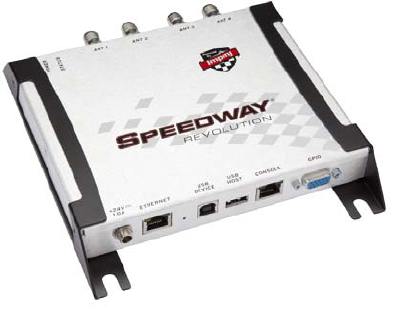
Speedway Revolution Installation and Operations Guide
2Copyright © 2009, Impinj, Inc.
• Speedway Revolution Embedded Developer’s Guide
This guide describes the Speedway Revolution platform and provides a high level
view of its architecture. It is intended for software engineers who are designing cus-
tom application software that will run on the Speedway Revolution reader.
• Octane LLRP
This guide, intended for software engineers, describes the LLRP capabilities sup-
ported by Speedway Revolution, including Impinj’s custom LLRP extensions. Note
that Octane is the name for the Speedway Revolution firmware.
Impinj Support Information
See the Impinj Support Web site (support.impinj.com) for information about obtaining
technical assistance. For guidelines about how to capture data for analysis by Impinj tech-
nical support personnel, see page 25.
Introduction to Speedway® Revolution
Speedway® Revolution is a stationary,
small form factor, UHF Gen 2 RFID tag
reader that provides network connectivity
between tag data and enterprise system
software. Built with the same industry-
leading quality, high performance, and
excellent reliability of Impinj’s original
Speedway reader, Speedway Revolution
offers a variety of new features that
increase its application flexibility:
•Low Power Consumption
With a low power consumption design,
Speedway Revolution is capable of using Power over Ethernet (PoE). Using PoE sim-
plifies deployment and dramatically reduces the costs and greenhouse gas emissions
(GHG) of your RFID infrastructure. Even when using PoE, however, Speedway Rev-
olution does not compromise on performance. It delivers the full 30 dBm transmit
power. Note that Speedway Revolution supports the IEEE standard 802.3af (for PoE).
• Compact Form Factor
The compact size of Speedway Revolution (7.4 x 6.9 x 1.2 in) eases installation in
tight spaces and embedded applications.
• Availability of Two Models
Impinj offers two Speedway Revolution models, with different high performance
monostatic (transmitter and receiver utilize the same port) antenna port configura-
tions. The R220 model is a two-port configuration, while the R420 is a four-port con-
figuration (shown in the above photograph).
• High Performance Features
Speedway Revolution utilizes a variety of high performance features making it possi-
ble to read more than 1100 tags per second. These features include Autoset, Low Duty
Cycle, dynamic antenna switching, inventory search modes that improve tag popula-
tion management, and receive sensitivity filtering for read zone confinement.
Chapter 1: Introduction
Copyright © 2009, Impinj, Inc. 3
• Ease of Use Features
Speedway Revolution uses industry-standard application interfaces, simplifying its
integration with RFID middleware or custom software solutions. In addition, it offers
enterprise-class management and monitoring capability.
• Robust Reader Design
Just like its Speedway predecessor, Speedway Revolution uses a single circuit board
design that delivers field-proven, enterprise-class quality and reliability.
Requirements for Using Speedway
Revolution
This section describes the key requirements for operating and interfacing with a Speedway
Revolution reader.
Environmental Requirements
• Operating temperature: -20º C to +50º C (non-condensing)
• Supported Regions: US, Canada, and other regions following US FCC Part 15 regula-
tions; European Union and other regions following ETSI EN 302 208 v1.2.1 without
LBT regulations
Hardware Requirements
• TCP/IP network equipment, as required to connect the reader to a PC, Mac, or other
network terminal. If you plan to use PoE, you must have either a power injector or a
network switch that supports PoE.
• Impinj-approved UHF RFID antenna(s), including associated RF cable(s) with RP-
TNC male connector interface
• A computer running Microsoft Windows XP, Vista, or Linux PC, which has:
• an available RS-232 serial port
• a Cisco Management Cable (RJ-45 to DB9)—to communicate over serial
• An Ethernet port
• Standard Ethernet cable(s)
Note: To use the MultiReader application (see page 13), you must be running Microsoft Win-
dows XP.
Power Requirements
As noted earlier, there are two options for powering your Speedway Revolution reader:
Power-Over-Ethernet (PoE) or an external universal power supply. PoE offers the most
efficient power consumption and supports up to +30 dBm. An external universal power
supply supports up to +32.5 dBm. Operating at +32.5 dBm requires professional installa-
tion. See “Appendix A: Information Specific to Regions of Operation” on page 27 for
details.
If using a universal power supply module, you must use a module with +24 VDC output
that has the following part number: IPJ-A2001-000. Use AC power cords with either of
the two part numbers: IPJ-A2051-USA (for North America) or IPJ-A2051-EU1 (for
European Union). You can order the universal power supply and power cords from Impinj.

Speedway Revolution Installation and Operations Guide
4Copyright © 2009, Impinj, Inc.
Supported Operating Environments
This section describes the environments in which you can access the Speedway Revolu-
tion Rshell console (for configuring, monitoring, and maintaining the reader). The tools
you use to access the Rshell console depend on how you connect your PC to the reader:
serial connection (RS-232) or Ethernet connection (SSH/Telnet). On PCs running
Microsoft Windows, you can now use the same tool—Putty—for both types of connec-
tions.
Supported Communication Protocol
For client control of the reader, Speedway Revolution supports the EPCglobal Low Level
Reader Protocol (LLRP) v1.0.1. LLRP is an EPCglobal standard interface that allows
communication with the reader and with EPCglobal Gen 2 RFID tags.
Antenna Requirements
Depending on the reader model you are installing, Speedway Revolution is equipped with
two (R220) or four (R420) monostatic antenna ports (independent, bidirectional, and full
duplex TX/RX).
Antenna requirements vary by regulatory region. For details about the requirements in a
specific region, see the relevant antenna section in “Appendix A: Information Specific to
Regions of Operation” on page 27.
Table 1: Speedway Revolution Operating Environments
Interface Protocol Recommended Tools
Microsoft Windows Linux
Ethernet SSH—Port 22
Telnet—Port
23
Putty1
1. (http://www.chiark.greenend.org.uk/~sgtatham/putty/)
SSH or Tel-
net
Serial RS-232 Putty (version 0.60 and
higher supports serial) Minicom
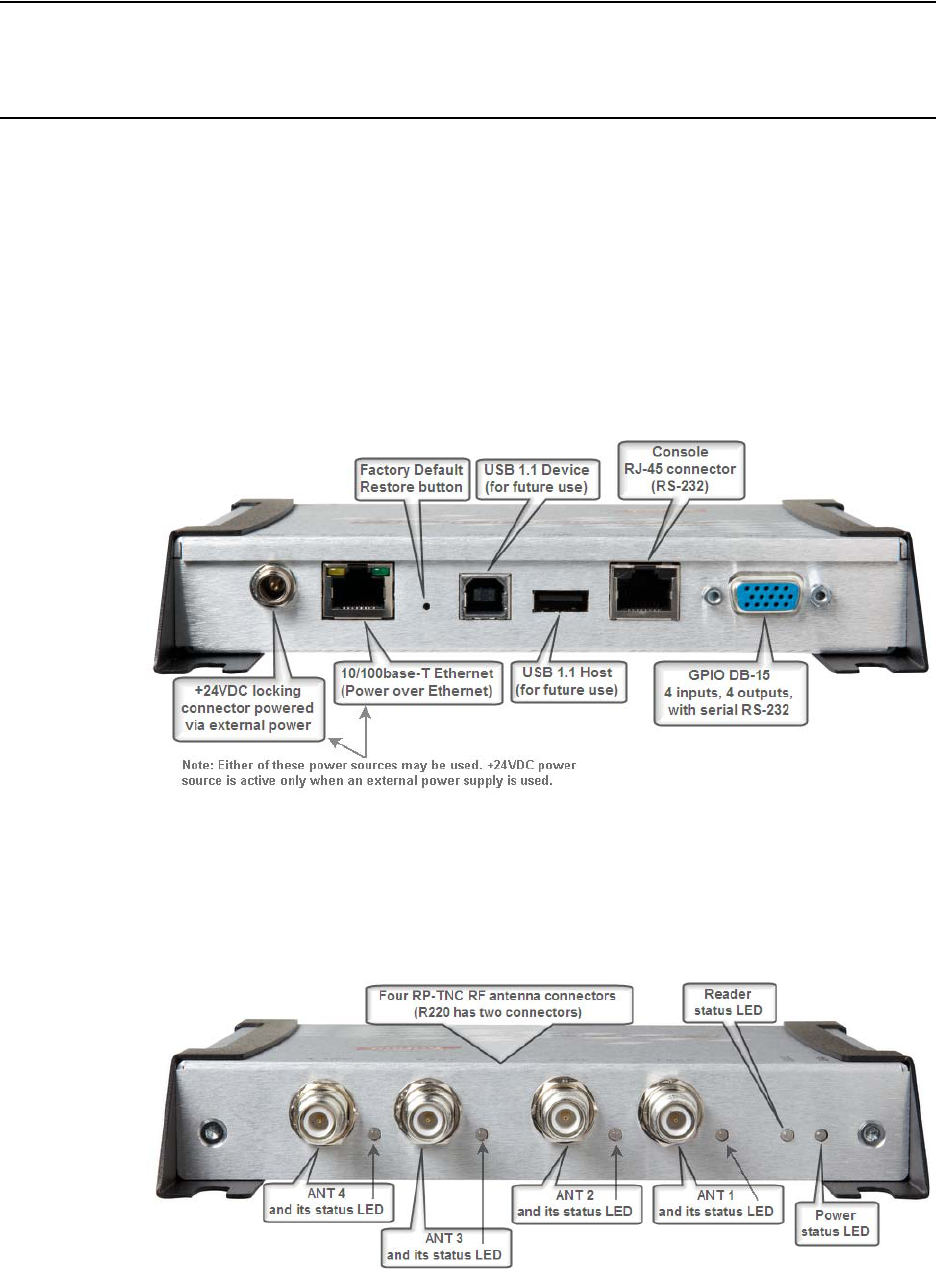
Chapter 2: Installing and Connecting Speedway Revolution
Copyright © 2009, Impinj, Inc. 5
Chapter 2: Installing and Connecting
Speedway Revolution
This chapter provides details about the Speedway Revolution I/O ports and status LEDs,
and explains how to install the reader and connect it to your network.
Speedway Revolution Ports and LEDs
The following graphic illustrates the various I/O ports located on the Speedway Revolu-
tion reader. This graphic illustrates a Speedway R420, which includes four antenna ports
(not visible in this view). Note that Speedway R220 includes two antenna ports. Other
than that difference, however, the exterior ports are the same on both models.
Figure 1: Speedway Revolution Port Connections
Note: For details about the function and electrical specifications for each pin of the GPIO DB-15
connector, see “Appendix B: GPIO Details” on page 31.
On the back side of the reader are the antenna ports and LED status indicators. The follow-
ing graphic (of an R420) illustrates their locations:
Figure 2: Speedway Revolution Antenna Ports and Status LEDs

Speedway Revolution Installation and Operations Guide
6Copyright © 2009, Impinj, Inc.
The following table describes the LED behavior for various reader states:
Table 2: Reader Operations and Associated Status LED Behavior
Reader Operation LED Expected Behavior
Startup (power on),
normal completion Power applied, attempting
to start boot code Power Solid red
Status Off
Bootloader calling firm-
ware image Power Solid green
Status Off
Bootloader completed suc-
cessfully, reader is ready Power Solid green
Status Solid green
Startup (reset),
normal completion Factory Default Restore
(FDR) button pressed Power Turns off
Status Off
FDR button pressed for 3
seconds Power Blinks once (red), indi-
cates a configuration
default restore will occur
Status Off
Startup (failure) Hardware problems
detected, unable to boot Power Continuous blinking red
Status Off
Upgrade activity Upgrading the firmware
during boot process Status Alternates between red
and green
Detection of
antenna activity Detects no activity on
antenna port Antenna Off
Detects antenna transmis-
sion activity on antenna
port
Antenna Solid green
Inventory activity Performing an inventory
operation Status Blinks orange, blinks
faster as tag volume
increases
LLRP activity Active LLRP connection Status Double blink pattern
(green)
LLRP activity Disconnected operation Status Single blink pattern
(green)
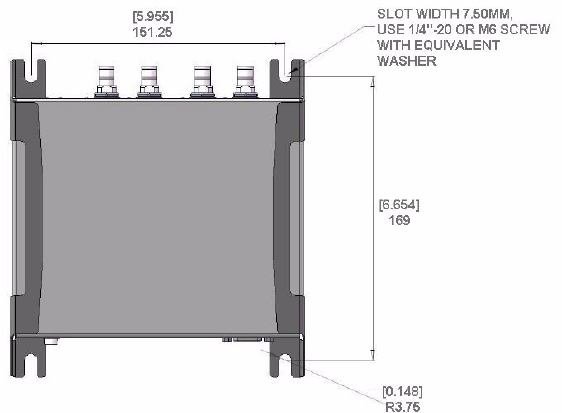
Chapter 2: Installing and Connecting Speedway Revolution
Copyright © 2009, Impinj, Inc. 7
Installing and Connecting the Reader
Listed below are the primary steps to follow to install and connect Speedway Revolution:
1. Position the reader appropriately for your environment. This may or may not involve
mounting the reader.
2. Connect the antenna(s) to the appropriate ports on the reader.
3. Connect the reader to the network.
4. Connect power to the reader.
5. Test the reader installation by reading some tags.
Detailed Installation Procedures
This section provides the details for each step listed above.
Step 1: Position the Speedway Revolution Reader
and (optionally) Mount the Reader
Choose the appropriate location for the reader. Generally speaking, you should always
keep the unit away from direct sunlight, high humidity, extreme temperatures, vibration,
and sources of electromagnetic interference. Any combination of these conditions may
degrade performance or shorten the life of the unit. Because the Speedway reader supports
Power over Ethernet (PoE), it can obtain its electrical power along with data via standard
cable in an Ethernet network. To minimize power loss, it is best to position the reader
within 100 meters of its power source. Or, if you plan to power the reader using an exter-
nal universal power supply, confirm that there is a standard 120 or 220 VAC outlet nearby.
Depending on your environment, you may need to mount the reader to a wall or another
object.
To mount the Speedway Revolution reader:
1. Locate the four mounting slots on the reader, as illustrated below:

Speedway Revolution Installation and Operations Guide
8Copyright © 2009, Impinj, Inc.
2. Using 1/4" - 20 or M6 screws, secure the unit. You can mount the reader horizontally
or vertically.
Caution: If there is any chance of dust or water exposure, you should mount the reader so that digi-
tal I/O ports are facing down to prevent ingress.
Step 2: Connect the Antenna(s) to the Speedway
Revolution Reader
Depending on the Speedway Revolution model you are installing, the reader has either
two antenna ports (R220) or four antenna ports (R420). Each port is independent, bidirec-
tional, and full duplex TX/RX (monostatic).
Warning: You must use Impinj-approved antennas with Speedway Revolution. See “Appendix A:
Information Specific to Regions of Operation” on page 27 for a detailed list of approved
vendors. Using any other antenna may adversely affect performance or damage the reader.
Speedway Revolution requires professional installation to correctly set the TX power for
the RF cable and antenna selected.
To connect the antenna(s) to Speedway Revolution:
1. Position each reader antenna, keeping the following points in mind:
• Position the antenna(s) to achieve the most effective and efficient tag reads.
• Position the antenna(s) to maximize operator safety. Personnel who will be in the
area for prolonged periods of time should be able to remain at a safe distance at all
times. See “Appendix A: Information Specific to Regions of Operation” on
page 27 for the specific requirements for your regulatory region.
2. Mount the antenna(s) according to the instructions provided by the antenna manufac-
turer.
3. Attach the antenna cable(s) to the antenna port(s) on the reader. You can choose any
port for any antenna.
4. Finger-tighten each connection, making sure it is secure. A loose connection nega-
tively impacts the performance of the antenna. The antenna cable is properly tightened
when you are no longer able to twist the cable inside the connector.
Caution: Impinj has designed the Speedway Revolution antenna ports to be self-terminating. There-
fore, it is important that you do not terminate unused antenna ports. Leave them uncon-
nected.
Step 3: Connect Speedway Revolution to the
Network
You are now ready to connect the installed Speedway Revolution to your network. You
have two options:
• If your network supports DHCP, you can connect the reader directly to your Ethernet
network and, once the reader is powered, immediately communicate with it via Telnet
(TCP/IP).
• If your network does not support DHCP, you will need to connect a PC directly to the
reader using a serial connection (RS-232), then use the reader’s Rshell command line
interface to configure a static IP address for the reader. At that point, you will be able
to connect the reader to your Ethernet network.
!
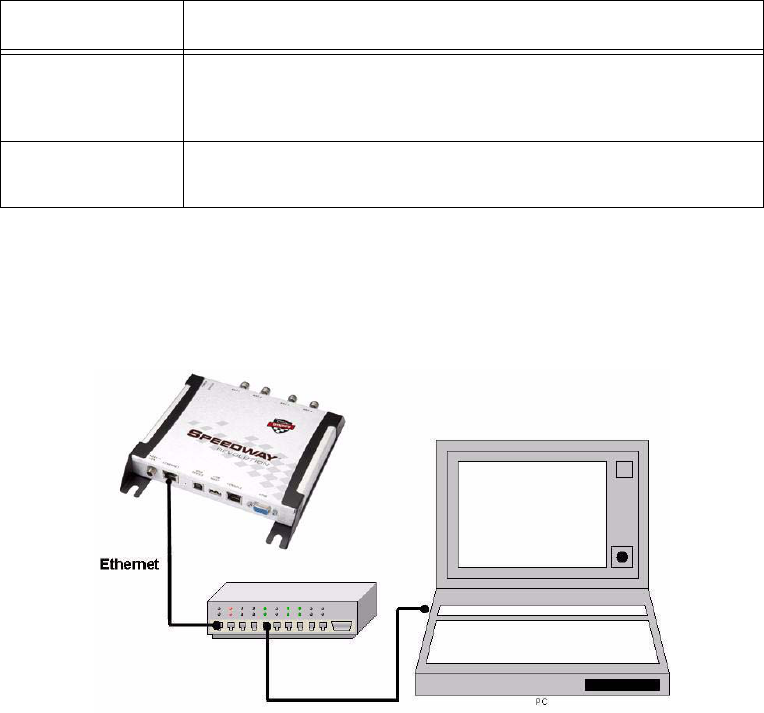
Chapter 2: Installing and Connecting Speedway Revolution
Copyright © 2009, Impinj, Inc. 9
The details of completing each connection option are discussed below. Before proceeding,
however, take note of the reader’s factory default network settings:
To connect Speedway Revolution to the Ethernet network:
• Using a standard Ethernet cable, connect the RJ-45 connector on the reader to a LAN
drop or network switch. A typical network configuration is illustrated below:
If your network switch is PoE-enabled, the reader will power on when you connect it
to the network. See “Step 4: Power the Reader” on page 11 for information about what
to expect.
Note: If you need to connect a PC directly to the Ethernet port, you can use a standard Ether-
net cable. A crossover cable is not necessary.
Table 3: Default Network Settings
Setting Description
hostname SpeedwayR-XX-XX-XX where XX-XX-XX is the last three
bytes of the reader’s MAC address (which is printed on the ver-
sion label attached to the reader enclosure)
DHCP Enabled. The reader also reports its hostname to the DHCP
server.
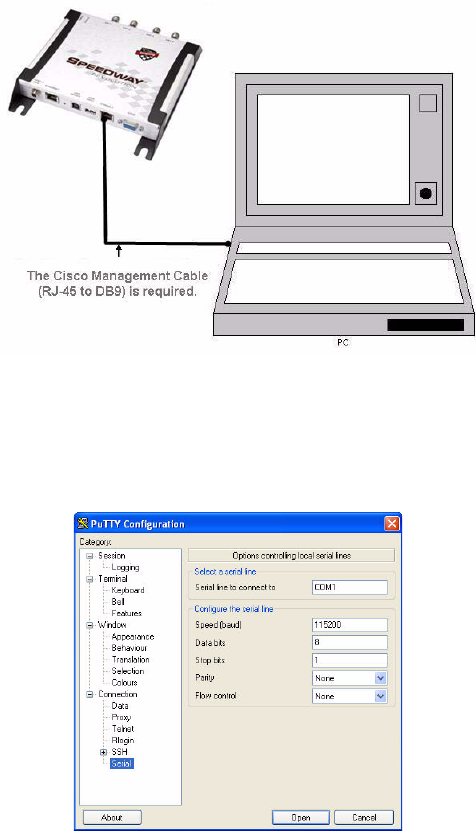
Speedway Revolution Installation and Operations Guide
10 Copyright © 2009, Impinj, Inc.
To connect Speedway Revolution to your PC over a serial
connection:
1. If necessary, download the latest version of Putty, which is a free and reliable SSH,
Telnet, and serial client. Version 0.60 or higher contains support for serial connections.
2. Using a Cisco management cable (RJ-45 to DB9, available from Impinj with a part
number of IPJ-A4000-000), connect your PC’s valid/active COM port to the serial
port on the reader, as illustrated below:
3. Power the reader and wait for the boot sequence to complete. (See “Step 4: Power the
Reader” on page 11.)
4. On the PC, run the Putty application and select the Serial connection option. Verify
that Serial line to connect to is set to COM1 (if that is correct for your PC). Set
Speed to 115200. Set Flow control to None.
5. Click Open. The Rshell console window opens.
6. Press Enter. The Rshell login prompt appears.
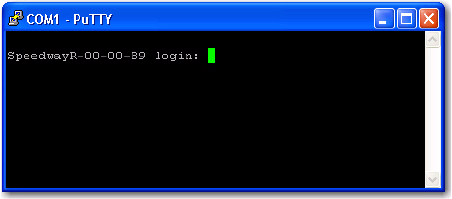
Chapter 2: Installing and Connecting Speedway Revolution
Copyright © 2009, Impinj, Inc. 11
7. Log in with the following default credentials (unless they have been changed):
User Name: root
Password: impinj
8. When the Rshell command line prompt appears, you can begin configuring the net-
work settings for the reader. See “Using Rshell to Configure Network Settings for
Speedway Revolution” on page 12 for details.
9. When you have completed configuration of the appropriate network settings, connect
the reader to your Ethernet network as described on page 9.
Note: If you decide to connect to DHCP after connecting serially, remember to use Rshell to
change the IP address on the reader from static to dynamic. See “Using Rshell to Config-
ure Network Settings for Speedway Revolution” on page 12 for details.
Step 4: Power the Reader
You have two choices for powering Speedway Revolution:
• Power over Ethernet (PoE)
• External universal power supply
If you are using PoE, your reader began receiving power when you connected it to the net-
work in the previous step. Therefore, there is nothing more you need to do. If you are
using an external universal power supply, connect the AC power plug into a suitable 100-
240 VAC, 50-60 Hz power outlet.
In either case, when power is supplied to the reader, it begins its boot sequence. This
sequence typically completes within 30 to 45 seconds. Until the boot sequence completes,
the reader will not accept commands. The Power and Status LEDs on the reader alert you
to what is happening. See Table 2 on page 6 for details.
Important: If a reader is receiving its power via PoE and it detects that an external universal power
supply has been connected, the reader reboots and switches its power source from PoE to
the external universal power supply. If, however, the reader is receiving power via an
external universal power supply and it detects the connection to a PoE-enabled network
switch, nothing changes. The reader continues to receive its power from the external sup-
ply. Because the external universal power supply is capable of higher power than PoE, it
always takes precedence if both sources are connected.
Step 5: Test the Installed Reader
To test that everything is connected and functioning properly, try reading some tags. The
easiest and quickest way to verify operation is by using the MultiReader application, a test
application from Impinj that is useful for quickly configuring various reader parameters
and running simple inventory operations. For details about how to access and use Multi-
Reader, see page 13.

Speedway Revolution Installation and Operations Guide
12 Copyright © 2009, Impinj, Inc.
Chapter 3: Configuring and
Monitoring Speedway Revolution
This chapter provides a high-level view of the configuration and monitoring options avail-
able for Speedway Revolution.
Configuring Speedway Revolution
You can think of Speedway Revolution configuration in two categories: configuration of
the device itself and configuration of the reader’s RF behavior. This chapter provides the
basics for each type of configuration.
Device Configuration
To configure and manage network settings, firmware upgrades, and other device-oriented
operations, you use Rshell, a proprietary command line management interface. This chap-
ter introduces the Rshell commands you are most likely to need when initially installing
and connecting the reader. You can find full details and syntax for all Rshell commands in
the Rshell Reference Manual.
Note: Rshell is designed to be a machine interface. As such, it is always backward-compatible
with previous Speedway Revolution versions. Existing inputs and outputs will never
change. New commands may be added, however, as well as new optional arguments
(which will always be added at the end).
Important: The Speedway Revolution version of RShell is NOT compatible with the original Speed-
way reader.
Using Rshell to Configure Network Settings for Speedway
Revolution
The default configuration settings in Speedway Revolution are often enough to get you up
and running with little to no configuration required. In some cases, especially if you are
not using DHCP to assign IP addresses, you will need to configure a few of the reader’s
network settings.
The following procedure outlines the Rshell commands you may need for connecting the
reader to your network.
To configure the reader’s network settings:
1. Open the Rshell console (see page 10 for details).
2. View the reader’s current configuration settings by issuing the show network sum-
mary command at the Rshell command prompt:
> show network summary
Status='0,Success'
PrimaryInterface='eth0'
ActiveInterface='eth0'
Hostname='SpeedwayR-00-00-B9'
connectionStatus='Connected'
ipAddressMode='Dynamic'
Chapter 3: Configuring and Monitoring Speedway Revolution
Copyright © 2009, Impinj, Inc. 13
ipAddress='10.0.10.41'
ipMask='255.255.0.0'
gatewayAddress='10.0.0.10'
broadcastAddress='10.0.255.255'
3. Configure the appropriate TCP/IP parameters for your environment. The applicable
commands are outlined below:
• Setting Hostname
> config network hostname <HOSTNAME>
• Setting Static IP Address
> config network ip static <IP ADDRESS> <NETMASK> <GATEWAY>
<BROADCAST>
Note that, except for the IP address, the other parameters are optional. If an
optional parameter is omitted from the ip command, its default value is used.
• Enabling DHCP
> config network ip dynamic
• Configuring NTP Servers
> config network ntp add <NTP SERVER ADDRESS>
4. After successfully configuring all required network settings, you can connect the
reader to the network via the Speedway Revolution Ethernet port.
RF Configuration
The approach you use to configure the reader’s RF behavior depends entirely on your
implementation. You may be using a custom software application, middleware running on
a server, or some other approach. MultiReader (see below) is an example of such a client
application. Regardless of the application you’re using, however, the underlying protocol
is the same—Low-Level Reader Protocol (LLRP), a standard, asymmetric, binary proto-
col used for communication between a client application and the reader. LLRP controls
configuration of such things as the antenna transmit power and receive sensitivity, the
mode in which the reader should operate, and more. For details about LLRP, see one or
more of the following documents:
•LLRP Standard: http://www.epcglobalinc.org/standards/llrp/llrp_1_0_1-standard-
20070813.pdf—This document provides the specifics of the EPCglobal-ratified LLRP
standard.
•Octane LLRP (Revision 4.2)—This document provides the details of the LLRP capa-
bilities supported by Speedway Revolution. It also describes the custom LLRP exten-
sions added by Impinj.
• Impinj LTK Programmer’s Guide—This guide, intended for software engineers, pro-
vides guidelines and best practices for working with the LLRP Toolkit. In addition,
software engineers can access language-specific reference guides and sample applica-
tions illustrating the scenarios discussed in the Programmer’s Guide.
Using MultiReader to Configure and Test Speedway
Revolution
Impinj provides a simple, easy-to-use LLRP application for configuring and testing the
basic RF behavior of Speedway Revolution. This application, called MultiReader, is avail-
able from the Impinj support Web site (support.impinj.com). To use MultiReader, your
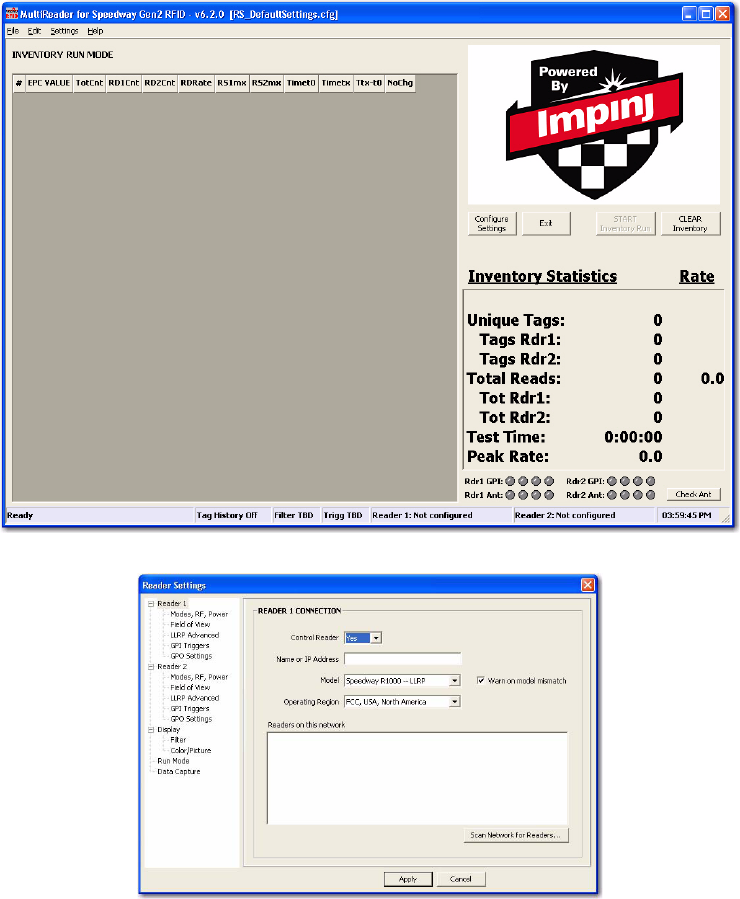
Speedway Revolution Installation and Operations Guide
14 Copyright © 2009, Impinj, Inc.
computer must be running Microsoft Windows XP. MultiReader is recommended for test
purposes only.
This section explains how to use MultiReader to connect to and configure a reader’s RF
parameters. It also provides a high level description of each parameter.
To configure and test a reader from within MultiReader:
1. Install and launch the MultiReader application. The following screen appears:
2. Click Configure Settings. The Reader Settings screen appears:
3. Connect to the reader by doing the following:
•In Name or IP Address, type the reader’s IP address (or host name). You can
determine the name and the IP address via the Rshell show network summary
command.
Note: The show network summary command will provide the dynamic values returned by
DHCP or LLA if the current configuration is dynamic. The local hostname resolution fea-
ture (mDNS) gives the reader a local hostname in addition to an IP address as its network
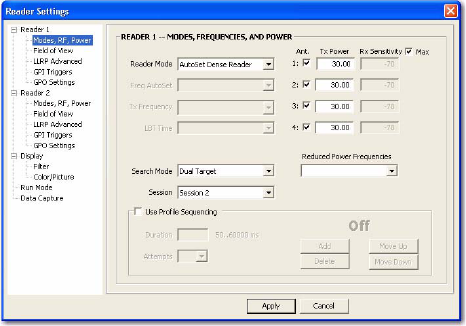
Chapter 3: Configuring and Monitoring Speedway Revolution
Copyright © 2009, Impinj, Inc. 15
identity. On an isolated network that lacks DNS service but has mDNS enabled, a reader
with hostname speedway-00-01-02, for example, may be reached using speedway-00-01-
02.local.
•In Model, select the appropriate Speedway Revolution model (either Speedway
R220 or Speedway R420). If you want MultiReader to issue a warning if it detects
a model other than what is configured, select the Warn on model mismatch
checkbox. It is selected by default.
4. Configure a few key RF parameters as described below:
•Under Reader 1 (in the list of readers on the left side), click Modes, RF, Power.
The following screen appears:
•In Reader Mode, select AutoSet Dense Reader. The Reader Mode specifies the
rules to use for communication between the reader and tag. With AutoSet Dense
enabled, the reader automatically senses the environment and adjusts its mode
accordingly.
•In Search Mode, select Dual Target. In Session, select Session 1. Search Mode
and Session work together to control when and how often the reader reads a tag.
Here is a very high level description of how it works: Each tag contains a flag that
is flipped from A to B or from B to A when it is read. The Session value controls
how long the flag retains its value before reverting back to its original value.
Search Mode controls which flag values the reader reads and, in some cases, what
happens to the flag value once the tag has been read. With Dual Target, the reader
reads all the tags with A flags, flipping each one to B after it has been read. When
there are no more A tags to read, the reader reads all the B tags, flipping each one
to A after it has been read. It continues this process back and forth from A to B
and back to A. Session 1 ensures a persistence period that prevents tags from
reverting before they have all been read.
• On the right of the screen is a checkbox for each of the reader’s antenna ports. By
default, they are all enabled. Disable any port to which no antenna is connected (in
other words, deselect the checkbox). Note that leaving all the ports enabled does
no harm, but it does waste processing time because the reader hops to all enabled
ports, verifying the presence of an antenna before attempting to activate it.
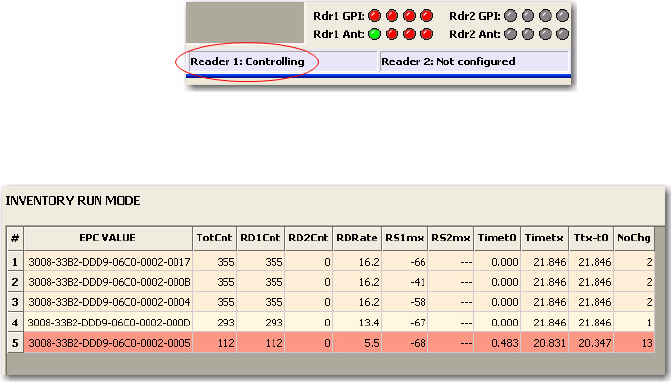
Speedway Revolution Installation and Operations Guide
16 Copyright © 2009, Impinj, Inc.
• For each enabled antenna, set the appropriate transmit power (Tx Power) and
receive sensitivity (Rx Sensitivity).
Transmit power controls the power of the signal leaving the antenna—and thus
controls the range of the signal. The optimal setting depends on many things: how
you are powering the reader, the cable length connecting the antenna to the reader,
the number of antennas in the area, the anticipated distance between the antenna
and the tags, and more. For testing purposes, you may want to use the default
value of 30 dBm. Note that the maximum configurable value is 32.5 dBm (if using
an external power source).
Receive sensitivity controls the tag signal threshold below which the tag is
ignored by the reader. This parameter is useful in mitigating stray reads (as stray
tags often have a weaker signal than the tags that are intended to be read). By
default, the Max checkbox is selected, which tells the reader to read all tags,
regardless of the tag’s signal strength (also known as its Received Signal Strength
Indicator—or RSSI). If you want to configure a specific receive sensitivity, dese-
lect the Max checkbox and type the value you want for each connected antenna.
Note that maximum sensitivity is -80.
Keep in mind that, for now, you are simply configuring the reader to test your
installation. You can always adjust these settings later when you begin using the
reader in a live RFID operation.
5. Click Apply. MultiReader displays a progress bar as it connects to the reader. When
the connection completes, the following status appears at the bottom of the applica-
tion:
6. It’s now time to test your reader installation. Place one or more tags in the read zone of
one or more of the attached antennas. Click START Inventory. Tag reads appear in
the large gray area on the left:
In this case, the reader detected five tags. Because the search mode is Dual Target, the
reader continuously reads the tags (first reading the A flags, and then reading the B
flags). Notice in the above image that one of the tag entries is a pinkish color. When a
tag is not being actively read, its entry begins changing to red. For example, if you
were to change the Search Mode to Single Target with Suppression (which tells the
reader to read a tag only once), all five entries would quickly turn red and stay red:
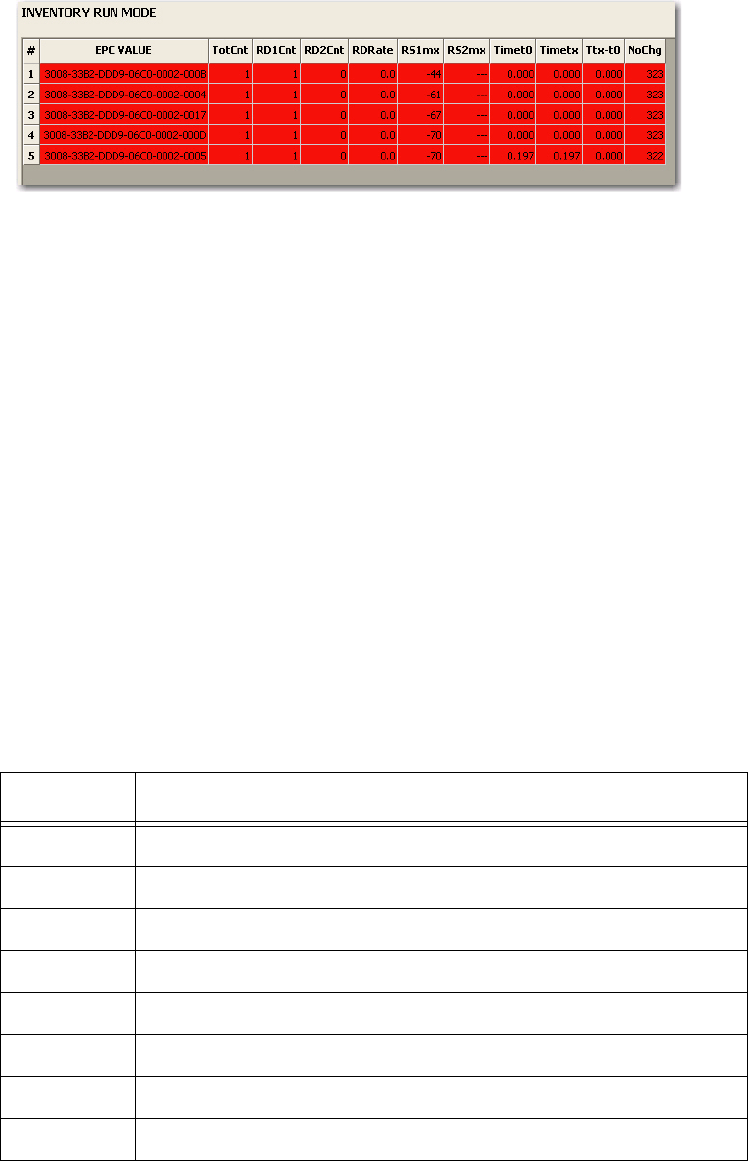
Chapter 3: Configuring and Monitoring Speedway Revolution
Copyright © 2009, Impinj, Inc. 17
So what is the bottom line? If you see tag data appearing in MultiReader, your reader
is most likely installed correctly and its antennas are functioning properly. If you don’t
see all the tags that you placed in the read zone, try moving them to a slightly different
location or placing them in a different orientation.
7. To stop the tag inventory, click STOP Inventory Run.
Monitoring Speedway Revolution
When Speedway Revolution is up and running, you can use Rshell to monitor its health
and performance. This section presents the primary Rshell commands to use for viewing
network and RFID statistics as well as the reader logs. For details about these commands,
see the Rshell Reference Manual.
Octane 4.2 adds support for SNMP and EPCglobal Reader Management MIBs. For more
information, see the Octane SNMP Guide.
Viewing Network Parameters and Statistics
Use the Rshell show network command to display networking parameters and statistics.
Using this command (along with the indicated parameters), you can view the following
information:
For details about the specific settings and statistics available for each of these parameters,
see the Rshell Reference Manual.
Table 4: show network Command Parameters
Parameter Displayed Information
dhcp Summary of DHCP client configuration
dns Summary of DNS settings
icmp ICMP statistics
ip IP statistics
ntp Summary of NTP settings
summary Summary of network settings
tcp TCP statistics
udp UDP statistics
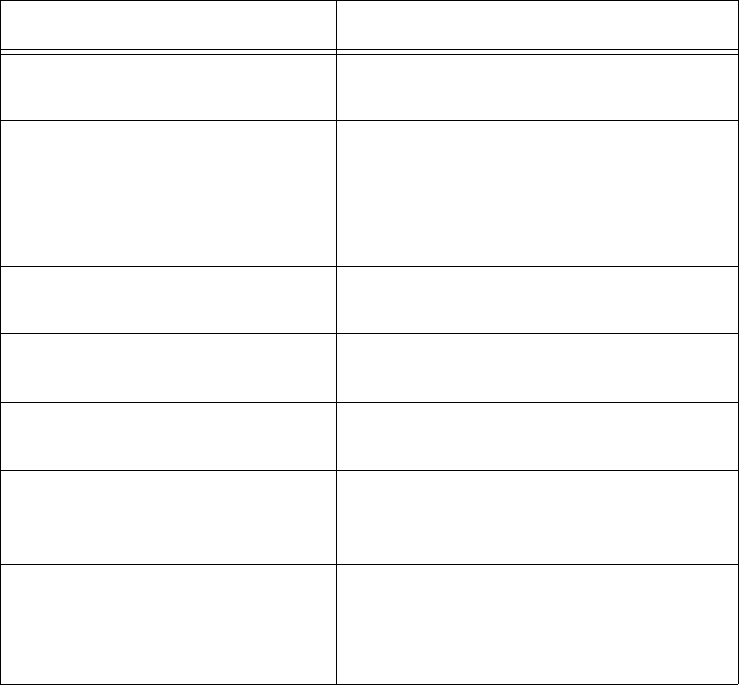
Speedway Revolution Installation and Operations Guide
18 Copyright © 2009, Impinj, Inc.
Viewing RFID Parameters and Statistics
Use the Rshell show rfid stat command to display a reader’s RFID parameters and
statistics. Using this command (along with the appropriate parameter), you can view such
information as:
Table 5 shows just a few of the RFID statistics available. For the full list as well as syntax
details, see the Rshell Reference Manual.
Note: You can also view statistics on the LLRP interface between the reader and a client by
entering the show rfid llrp command. See the Rshell Reference Manual for details.
Configuring and Viewing Speedway Revolution
Logs
Speedway Revolution uses the standard Syslog protocol to forward its logged events to a
remote Syslog server. The reader also stores the logged events in its filesystem, accumu-
lating and persisting this information across reboots. Logs are classified into three catego-
ries: Management, RFID, and System.
All logged events have an associated severity level. There are eight possible levels which
are listed below in decreasing order from most severe to least severe:
Table 5: Partial Listing of show rfid stat Parameters
Parameter Displayed Information
ReaderOperationalStatus Indicates whether RFID applications are
running on the reader
Antenna<n>OperationalSta-
tus
Indicates if an antenna is physically con-
nected to the reader and operating prop-
erly.
Note that <n> indicates the antenna port on
the reader (1-4).
Antenna<n>EnergizedTime Indicates the time that antenna<n> has
been powered, in milliseconds.
Antenna<n>UniqueInventory-
Count
Indicates the number of unique tags seen at
antenna<n>
Antenna<n>TotalInventory-
Count
Indicates the total inventory count for
antenna<n>
Antenna<n>ReadCount Indicates the number of tags read at
antenna<n> that matched the configured
filters.
Antenna<n>FailedReadCount Indicates the number of tags where a read
was attempted at antenna<n> because the
tag matched the configured filter, but the
read failed.
Chapter 3: Configuring and Monitoring Speedway Revolution
Copyright © 2009, Impinj, Inc. 19
• Emergency
•Alert
• Critical
• Error
•Warning
•Notice
•Info
•Debug
You can configure the log levels you want to see. The reader then retains only the events
with a severity greater than or equal to the configured level. For example, if you choose a
logging level of Warning, then the logs will contain the following levels: Warning, Error,
Critical, Alert, and Emergency.
Note: Regardless of the configured log level, the reader retains all Error level logs (and higher)
in an independent error log.
Use the Rshell config logging command to configure options for the storage and for-
warding of logged events. Use the show logging command to display the logging con-
figuration as well as the actual logged information (in text form). For details about these
commands, see the Rshell Reference Manual.
Viewing the State of the Speedway Revolution
Device
To display information about the current state of the reader itself, use the Rshell show
system command. Using this command, you can view the following statistics:
• A summary of system information—show system summary
• Platform memory usage and available application space—show system cpu
• Generic platform statistics—show system platform
For more details about the show system command, see the Rshell Reference Manual.

Speedway Revolution Installation and Operations Guide
20 Copyright © 2009, Impinj, Inc.
Chapter 4: Upgrading the
Speedway Revolution Firmware
Speedway Revolution contains firmware (known as Octane) which you may periodically
want to upgrade. This chapter explains how to manually upgrade a single reader.
In addition to supporting upgrade procedures, Speedway Revolution also provides meth-
ods for reverting its firmware to a previous valid image and for restoring its firmware to
factory default settings. The procedure for reverting to the previous image is explained in
this chapter, while returning to factory defaults is explained on page 23.
A Brief Overview of the Speedway
Revolution Firmware
To minimize downtime and maximize the robust handling of possible upgrade failures,
Speedway Revolution contains dual images of its firmware. When an upgrade is
requested, the reader continues to operate using the primary image while, in the back-
ground, it upgrades the secondary image. When the upgrade completes, the reader reboots
to the new upgraded image, but retains the previous firmware version on the other image.
This approach makes it easy to revert to the previous working version in case there are any
problems with the upgraded image.
Within each firmware image are three individual partitions that logically organize the sys-
tem software. Although you do not need a full understanding of this architecture to per-
form a simple manual upgrade, it is a good idea to be familiar with its structure at a high
level. For a more in-depth discussion of the firmware and how it is organized, see the
Embedded Developer’s Guide.
Following are high-level descriptions of the firmware’s three partitions:
•System Operating Partition (SOP)—The SOP is the primary system partition of the
Speedway Revolution reader. It contains the Linux kernel, the FPGA firmware, the
RFID management software, the reader management software (Rshell), the logging
management software, the firmware upgrade control, the system watchdog software,
and the factory default data.
•System Persistent Partition (SPP)—Files in this partition are automatically gener-
ated and maintained by the software running on the reader. It contains the reader con-
figuration (network settings, LLRP configuration, log settings, and so on), reader logs,
and debug information used by Impinj engineers.
•Custom Application Partition (CAP)—This partition contains custom application
software, other items required by the custom application (extra libraries or tools, con-
figuration files), and custom application logs.
Upgrading the Firmware
Speedway Revolution provides two methods for upgrading the firmware—manual and
automatic. The manual method, which is accomplished by issuing commands from within
Chapter 4: Upgrading the Speedway Revolution Firmware
Copyright © 2009, Impinj, Inc. 21
the Rshell console, is best for upgrading individual readers. The automatic method, which
involves the use of an upgrade configuration file called a metafile, is useful for automating
the upgrade of a large number of readers. As previously mentioned, the focus of this guide
is the manual method.
To upgrade the Speedway Revolution firmware:
1. Obtain the firmware upgrade file from the Impinj support Web site (sup-
port.impinj.com). The upgrade file always has an extension of .upg.
2. Place the upgrade file on a server (http, tftp, or ftp) that is accessible by the reader you
are upgrading.
3. Using the putty application, connect and log in to the reader.
4. From the Rshell command prompt, issue the following command:
>config image upgrade <URI>
where <URI> is the server location and name of the upgrade file.
For example:
>config image upgrade http://usacorp/rfid/reader/image/
OCTANE_4_0_0.upg
>config image upgrade ftp://anonymous:abc@myserver/
ftpdirecotry/image_4_2_0.upg
>tftp://server/sop_3_2_1_RC5.upg
1. After starting the upgrade, you can view the upgrade status at any time by issuing the
following command:
>show image summary
This command provides the current upgrade status, the last operation, the status of the
last operation, and information about the primary and secondary images. You can con-
tinue to reissue the show image summary command if you want to keep an eye on
the upgrade status. Some of the status values you may see are:
WaitingForImageFileTransfer
WaitingForCommitImage
WaitingToActivateImmediate
The upgrade is complete when the UpgradeStatus parameter value is Ready. The
LastOperation parameter should be WaitingToActivateImmediate and the Last-
OperationStatus should be Waiting for manual reboot.
2. Reboot the reader by issuing the following command:
>reboot
Speedway Revolution goes through its reboot process, displaying messages in the
Rshell console as it goes through each stage of the process. When the reboot com-
pletes, the reader login prompt appears on the console and the status light on the
reader is solid green. (See page 6 for details about the LED behavior to expect when
the reader is booting up.)
3. Log in to the reader.
Speedway Revolution Installation and Operations Guide
22 Copyright © 2009, Impinj, Inc.
To fall back to the previous image
1. If you need to revert to the pre-upgrade image, simply issue the following command
from the Rshell prompt:
config image fallback
When the command completes successfully, the reader reboots automatically and
returns to the login prompt.
2. Log in to the reader. It is now running the pre-upgrade image.
Note: If there is no valid previous image, the response to the config image fallback com-
mand is Status=‘8,Permission-Denied’.
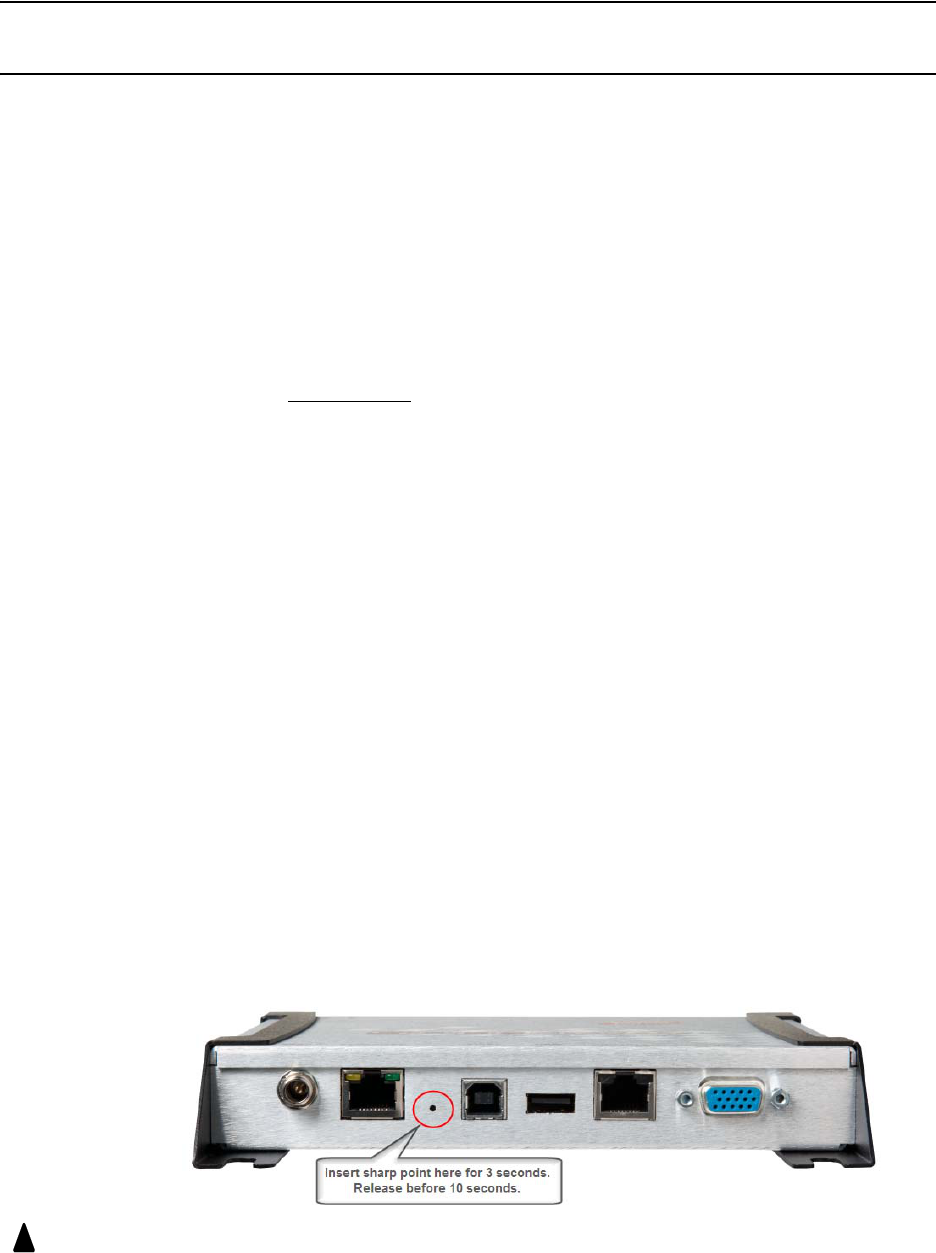
Chapter 5: Troubleshooting
Copyright © 2009, Impinj, Inc. 23
Chapter 5: Troubleshooting
This brief chapter presents a few suggestions of things to try if you experience problems
with Speedway Revolution.
Returning to the Factory Default
Configuration
If you are experiencing problems with the reader and are having difficulty pinpointing the
cause, it is often useful to return the reader to a known state (in this case, the factory
default configuration) and try again.
Important: Factory Default Configuration Restore returns the reader configuration to its default state,
but leaves any custom applications installed in the CAP intact. To restore the reader to its
default state AND remove any CAP contents, use Factory Default Restore. See “Warn-
ing:” on page 23.
There are two ways to return Speedway Revolution to its factory default configuration—
issuing an Rshell command or pushing the Factory Default Reset (FDR) button on the
device itself.
To use Rshell to return the reader to its factory default configuration
(leaving CAP intact):
1. At the Rshell prompt, issue the following command:
config image default
When the command completes successfully, it automatically reboots the reader and
returns to the login prompt.
2. Log in to the reader. It is now running with its factory default configuration.
To use the FDR button on the reader to restore to its factory default
configuration:
1. Using an object with a sharp tip (for example, a paper clip), press the FDR button on
the back of the reader (while applying power). When the Power LED turns off, wait
for 3 seconds (while watching the Power LED). When you see the LED blink red once
(this should occur at 3 seconds), release the FDR button. At this point, the reader will
boot up normally.
Warning: Pressing the FDR button for longer than 3 seconds can cause a factory default restore
to occur. Unlike a factory configuration restore, the factory default restore removes
!

Speedway Revolution Installation and Operations Guide
24 Copyright © 2009, Impinj, Inc.
the reader’s custom application partition (CAP), if one exists, returning the unit to its
state as shipped from the factory. Although there may be situations in which this
removal is necessary, it’s important to avoid accidentally removing the CAP.
The following table lists the factory default configuration values:
Table 6: Factory Default Configuration Values
Parameter Default Value
User root
Password impinj
Upgrade Retrieve Mode Manual
Logging No syslog servers
Management Logging Level Error
RFID Logging Level Error
System Logging Level Error
Network Mode Dynamic (DHCP)
DHCP Send Hostname On
DHCP User Class None
Hostname speedwayr-xx-xx-xx
(where xx-xx-xx are the last three digits of the
MAC address)
Static DNS Servers None
Static NTP Servers None
LLRP Inbound Port 5084
LLRP Inbound Service Enabled
LLRP Outbound Service Enabled
LLRP Outbound Servers None
LLRP Outbound Retry Secs 5
LLRP Outbound Timeout Secs 2
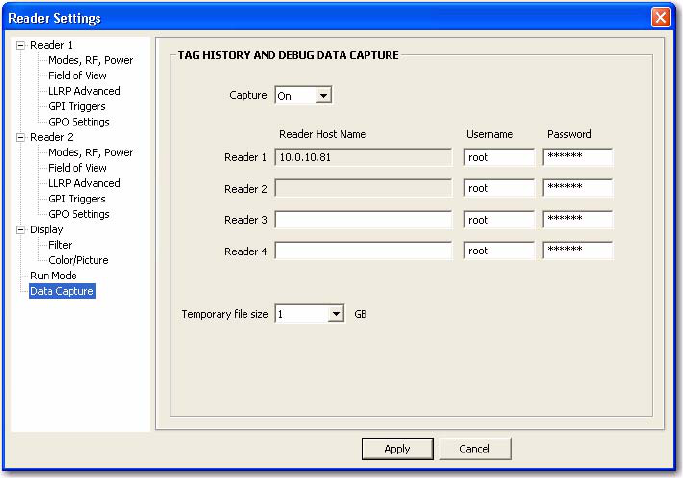
Chapter 5: Troubleshooting
Copyright © 2009, Impinj, Inc. 25
Submitting Diagnostic Data for Analysis
by Impinj Technical Support
If Speedway Revolution is exhibiting RF behavior that differs from what you expected
and you are unable to determine the cause, you may want to submit relevant data for anal-
ysis by Impinj Technical Support. Using the Impinj MultiReader application, you can eas-
ily capture data related to the problem scenario (by creating a Reader Diagnostic Data
file), which you can send to Impinj.
Note: An alternative is to create a network trace using Wireshark, a free protocol analyzer that
you can download from the Internet.
To capture data to a Reader Diagnostic Data file:
1. Open MultiReader and connect to the appropriate Speedway Revolution reader. (See
page 13 for details.)
2. Click Configure Settings to open the Reader Settings screen.
3. Verify that you are viewing the connection settings for Reader 1. If you are not, click
Reader 1 in the menu on the left.
4. In Control Reader, select No. This setting value tells MultiReader that you do not
want the MultiReader configuration controlling the reader. Changing this value is
important because you most likely want to capture data for a reader operation that is
being controlled by your application. If, however, you want to capture an RF scenario
that is controlled by MultiReader, set Control Reader to Yes.
5. In the menu on the left, click Data Capture. The following screen appears:
As you can see, Reader 1 is already populated with the IP address. Also note that the
login parameters are also populated. If these values are incorrect, you can change
them here. Also note that you can capture data for up to four readers simultaneously.
In this example, we are capturing data for only one reader.
6. Confirm that Capture is set to On.
Speedway Revolution Installation and Operations Guide
26 Copyright © 2009, Impinj, Inc.
7. Click Apply. MultiReader connects to the reader and begins “listening” for any RF
activity. At this point, it will capture data surrounding any RF activity it detects.
8. Perform the RF activity that you want to submit for analysis.
9. When you have completed the activity you want to capture, select the File menu in the
upper left corner of the application.
10. Click Save Debug Data.... A browse window opens.
11. Type a name for the file and save it in the desired location.
12. Send the .rdd file to Impinj Technical Support. For details about how to submit the
file, talk with your Impinj representative or visit the Impinj support Web site (sup-
port.impinj.com). Note that this file contains binary data.
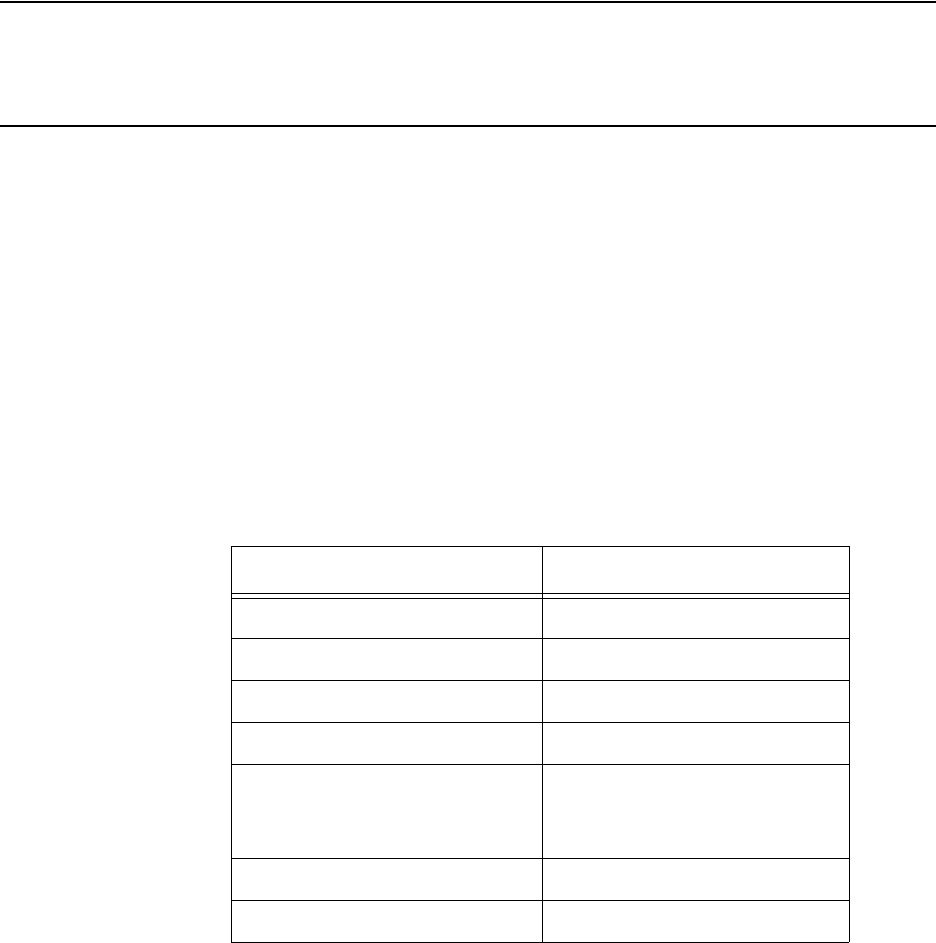
Appendix A: Information Specific to Regions of Operation
Copyright © 2009, Impinj, Inc. 27
Appendix A: Information Specific
to Regions of Operation
Speedway Revolution is designed to work in various regulatory regions. This appendix
includes frequency ranges and antenna requirements specific to each supported region.
Important: For each region, the reader is locked such that it can operate only in the specific frequen-
cies for that region. The region-specific frequencies are listed in this appendix.
Operation in North America
Frequency Plan
The FCC specifies frequency hopping across the North American spectrum allocated to
UHF RFID (902–928 MHz, with hopping occurring between 902.75–927.25 MHz in 500
KHz steps). The frequency plan is further explained in the table below:
Antenna Requirements
Positioning
Position the antenna such that personnel who will be in the area for prolonged periods of
time can remain at least 25 centimeters from the antenna’s surface. This positioning is
required by the FCC. For more details, see the following FCC bulletins:
• FCC OET Bulletin 65: Evaluating Compliance with FCC Guidelines for Human
Exposure to Radiofrequency Electromagnetic Fields
• FCC OET Bulletin 56: Questions and Answers about Biological Effects and
Potential Hazards of Radiofrequency Electromagnetic Fields
Table 7: Frequency Plan for North America
Transmit Channel Number Center Frequency (MHz)
1 902.75
2 903.25
3 903.75
4 904.25
.
.
.
.
.
.
49 926.75
50 927.25
Speedway Revolution Installation and Operations Guide
28 Copyright © 2009, Impinj, Inc.
Installation
Because Speedway Revolution is capable of up to +32.5 dBm conducted power on the
housing RF connector, professional installation is required.
Power
Speedway Revolution may only be operated with Impinj-approved antennas and can radi-
ate no more than 36 dBm EIRP per FCC Part 15.247 regulations. The Speedway Revolu-
tion output power may be increased to provide the maximum allowable EIRP subject to a
maximum conducted power allowance as well. The maximum conducted power at the
antenna connector can be no more than 30 dBm. The maximum allowable output power of
the reader can be set to satisfy both the conductor and radiated maximum criteria. The
expression for the maximum reader power setting is:
Maximum power setting (in dBm)
= The Smaller of
(36 - Composite Antenna Gain (in dBm))
OR
(30 + Cable Loss (in dBm)),
where the composite antenna gain comprises the maximum linear antenna gain in dBi
minus any cable loss between the reader and antenna in dB. Approved antenna vendors,
model numbers, and associated gain are listed in the next section.
Approved Antennas
• Cushcraft model number S9028PCL/R (left- or right-hand CP), with integrated 8 foot
pigtail to RP-TNC male connector; 6 dBi composite gain
• Impinj model number IPJ-A0301-USA (Mini-Guardrail) with SMA female connector;
-15 dBi gain
• Impinj model number IPJ-A0310-USA (Threshold-T Antenna) with 12 inch inte-
grated pigtail to BNC male connector, 6 dBi composite gain.
• Impinj model number IPJ-A0400-USA, CSL CS-777-2 (Brickyard) with 7 foot inte-
grated pigtail to RP-TNC male connector; 2 dBi composite gain
• Impinj model number IPJ-A0401-USA or IPJ-A0402-USA (both Guardwall) with 6
foot integrated pigtail to RP-TNC male connector; 6 dBi composite gain
• MA/COM MAAN-000246-FL1 integrated RFID floor-mounted stand (multiple con-
figurations available, 2 or 4 antennas left-hand and right-hand CP) with 8 foot inte-
grated pigtail to RP-TNC male connector; 6 dBi composite gain
• MA/COM MAAN-000246-WL1 integrated RFID wall-mounted stand (multiple con-
figurations available, 2 antennas left-hand and right-hand CP) with 8 foot integrated
pigtail to RP-TNC male connector; 6 dBi composite gain
• MTI MT-262006/TLH (left-hand CP) or MT-262006/TRH (right-hand CP) with RP-
TNC female connector (antennas available in IP54 or IP67 ratings); 6 dBi gain
• MTI MT-262013/NLH (left-hand CP) or MT-262013/NRH (right-hand CP) with N-
type female connector (antennas available in IP54 or IP67 ratings); 4.5 dBi gain
• MTI MT-262013/TLH (left-hand CP) or MT-262013/TRH (right-hand CP) with RP-
TNC female connector (antennas available in IP54 or IP67 ratings); 4.5 dBi gain
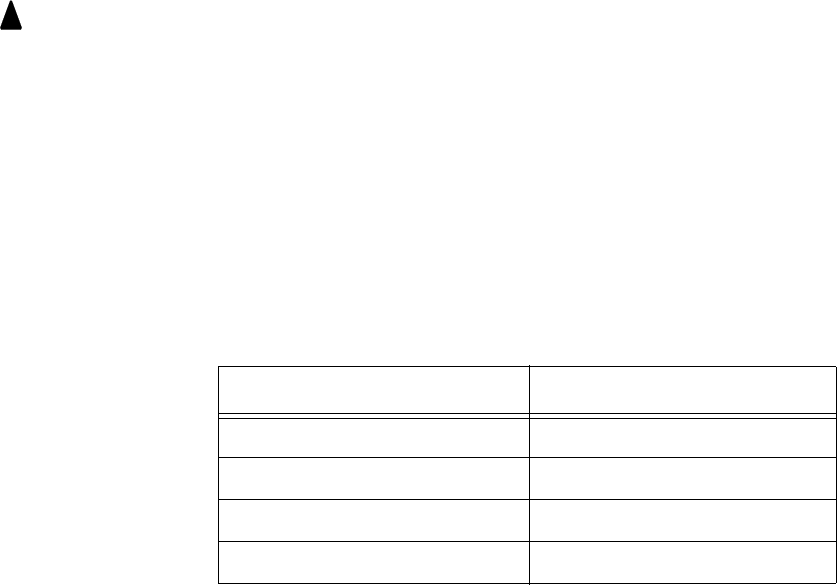
Appendix A: Information Specific to Regions of Operation
Copyright © 2009, Impinj, Inc. 29
• Sensormatic Electronics Corp. model number IDANT20TNA25 with 25 foot Belden
7806A RG-58 coaxial cable (0.1 dB per foot loss) to RP-TNC male connector; 5.5 dBi
composite gain
• Sensormatic Electronics Corp. model number IDANT10CNA25 with 25 foot Belden
7806A coaxial cable (0.1 dB per foot loss) to RP-TNC male connector; 3.5 dBi com-
posite gain
• Sensormatic Electronics Corp. model number IDANT10CNA25 with 6 foot Belden
7806A coaxial cable (0.1 dB per foot loss) to RP-TNC male connector; 5.4 dBi com-
posite gain
Warning: The use of any antenna not listed above may damage the reader or adversely affect perfor-
mance.
Operation in European Union
Frequency Plan
For European operation, the Speedway Revolution readers support the frequency plan
listed in Table 8 and is compliant with the ratified ETSI EN 302 208 specification v.1.2.1.
This specification states that no listen-before-talk is performed, the maximum continuous
transmit time on a channel is four seconds, and the reader enforces the 100 ms off time
before reusing the same channel.:
Antenna Requirements
Power
European regulations allow a maximum radiated power of 33 dBm ERP (Effective
Radiated Power) for high power RFID systems. The maximum Speedway Revolu-
tion output power is determined by the following equation:
Maximum power setting (in dBm) = 33 – Antenna Gain (in dBd) + Cable loss (in dB)
For example, for an application with an antenna gain of 6 dBd and cable loss of 2
dB, the reader output power can be set no higher than 33-6+2 = 29 dBm. The max-
imin transmit power of Speedway Revolution is 31.5dBm measured at the RF
antenna port. Note that it is important to apply the antenna gain expressed in dBd
(dB with respect to a dipole), which is equivalent to the isotropic antenna gain (in
dBi) minus 2.15 dB. Additionally, the antenna gain used to set the output power
!
Table 8: Frequency Plan for European Union
Transmit Channel Number Center Frequency (MHz)
4 865.7
7 866.3
10 866.9
13 867.5

Speedway Revolution Installation and Operations Guide
30 Copyright © 2009, Impinj, Inc.
must be the maximum linear gain of the applicable antenna. Approved antenna
vendors, model numbers, and associated gain are listed in the next section.
Approved Antennas
• Cushcraft Model Number S8658PCL/R (left- or right-hand CP) with integrated pigtail
to RP-TNC male connector; 3.85 dBd gain
• Impinj Model Number IPJ-A0400-EU1, CSL CS-777-1 (Brickyard) with 7 foot inte-
grated pigtail to RP-TNC male connector; 0 dBd composite gain
• MTI MT-242032/NLH (left-hand CP) or MT-242032/NRH (right-hand CP) with N-
type female connector (antennas available in IP54 or IP67 ratings); 1.85 dBd gain
• Sensormatic Electronics Corp. Model number IDANT10CEU25 (left-hand CP only)
with 6 foot Belden 7806A coaxial cable (0.1 dB per foot loss) to RP-TNC male con-
nector; 3.25 dBd composite gain
Warning: The use of any antenna not listed above may damage the reader or adversely affect perfor-
mance.
!
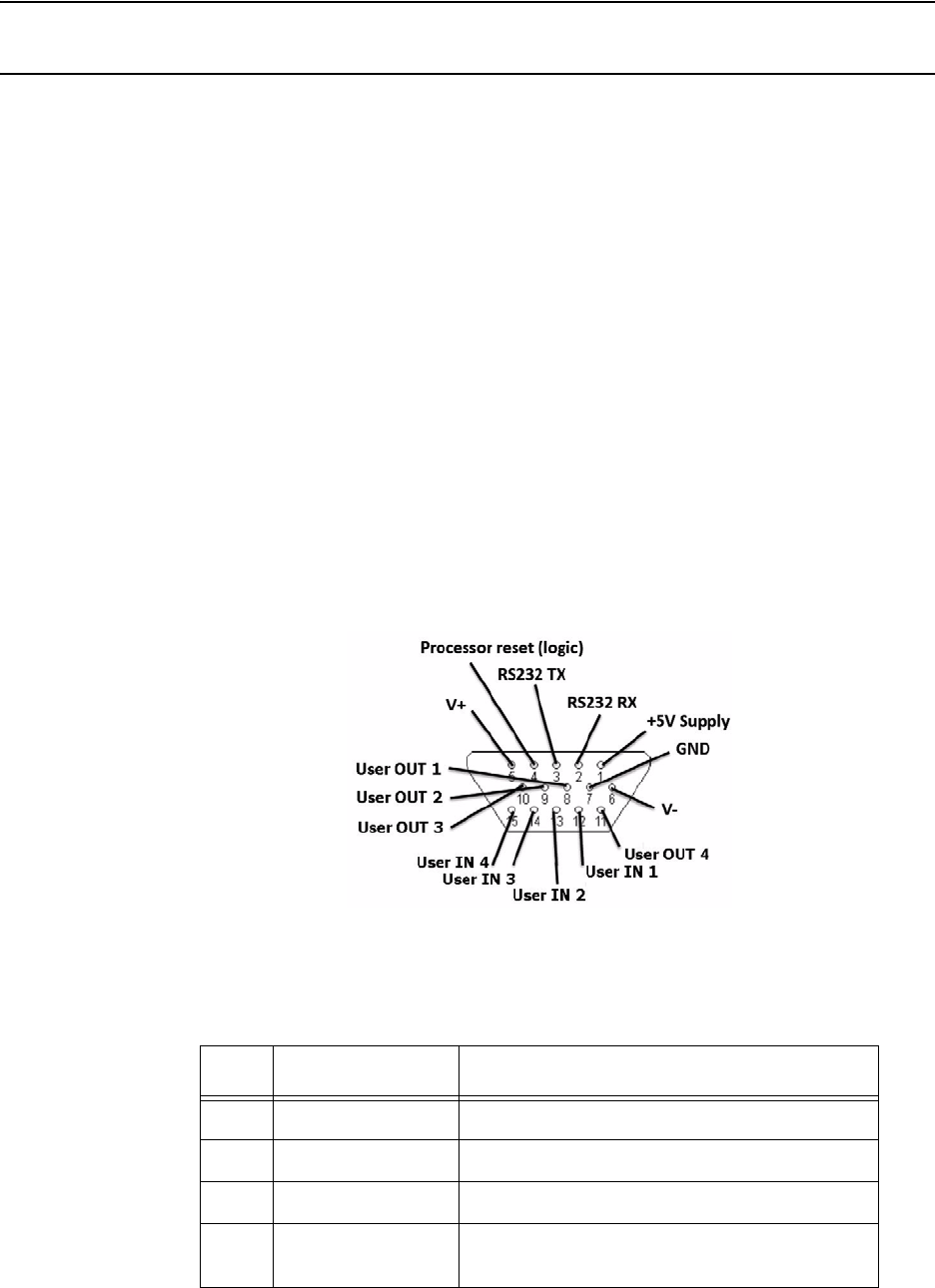
Appendix B: GPIO Details
Copyright © 2009, Impinj, Inc. 31
Appendix B: GPIO Details
Speedway Revolution includes a multipurpose I/O port that contains an RS-232 serial
port, four opto-isolated inputs, four opto-isolated outputs, and a +5V supply. You access
these features through a DE15 connector mounted on the side of the reader.
The four opto-isolated inputs have a range of 0–30V. The reader treats an input of 0–0.8V
as a logic 0, and an input of 3–30V as a logic 1. The reader has a per-input debounce inter-
val that is configurable via LLRP (see the document titled Octane LLRP for more informa-
tion). This value dictates the minimum pulse width of an input. Impinj recommends that
external devices guarantee a minimum pulse width of at least 100 milliseconds.
The reader also provides four opto-isolated outputs. For the GPIO outputs to function, an
external user supply must be connected between V+, and V-. The maximum voltage for
this supply is 30V. When the user configures a selected GPIO output via LLRP to output
logic 0, an isolated FET switch within the reader effectively shorts that output to V- with a
current sink capability of up to 200mA. When the user configures a selected GPIO output
to logic 1, the selected output is pulled to V+ through a 10K resistor. If GPIO isolation is
not required, the reader provides a +5V supply and a ground pin on the DB-15 that can be
connected to V+ and V-.
Figure 3 shows the detailed function of each pin of the GPIO DB-15 connector.
Figure 3: DB-15 GPIO Port
Note: As described above, both the input and output pins are opto-isolated.
Table 9 and Table 10 further explain the function of each pin.
Table 9: DB-15 Connector Pin-Out
Pin I/O Name I/O Function
1 +5V Supply Reader supplied (not isolated) power source
2 RS-232 RX For auxilliary serial port functions
3 RS-232 TX For auxilliary serial port functions
4 Processor Reset Reserved for future use. Do not connect this
pin to any signal.

Speedway Revolution Installation and Operations Guide
32 Copyright © 2009, Impinj, Inc.
*User-supplied voltage
5 V+ Power source for isolated outputs
6 V- Return for isolated inputs and outputs
7 Ground Reader (not isolated) return
8 User OUT 1 Isolated output 1 (active pull down to V-)
9 User OUT 2 Isolated output 2 (active pull down to V-)
10 User OUT 3 Isolated output 3 (active pull down to V-)
11 User OUT 4 Isolated output 4 (active pull down to V-)
12 User IN 1 Isolated input 1
13 User IN 2 Isolated input 2
14 User IN 3 Isolated input 3
15 User IN 4 Isolated input 4
Table 9: DB-15 Connector Pin-Out
Pin I/O Name I/O Function
Table 10: GPIO Interface Electrical Specification
Pin Parameter Description Min Max Unit Conditions
+5V Supply IOOutput current 200 mA
User IN 1-4 VIH HIGH level input voltage 3 30 V
User IN 1-4 VIL LOW level input voltage 0 0.8 V
User IN 1-4 ILI Input current 5 mA 24V input
User IN 1-4 VIInput voltage range 0 30 V No damage
User OUT 1-4 VOH Output high voltage V+* V 10k pullup
User OUT 1-4 VOL Output low voltage (V-)+0.5 V 100mA load
User OUT 1-4 VISupply voltage range
(V+ - V-) 30 V
Appendix B: GPIO Details
Copyright © 2009, Impinj, Inc. 33
Copyright © 2009, Impinj, Inc. All rights reserved.
Notices
The information contained in this user guide is confidential and proprietary to Impinj, Inc. This
document is conditionally issued, and neither receipt nor possession hereof confers or transfers any
right in, or license to, use the subject matter of any drawings, design, or technical information con-
tained herein, nor any right to reproduce or disclose any part of the contents hereof, without the
prior written consent of Impinj and the authorized recipient hereof.
Impinj reserves the right to change its products and services at any time without notice.
Impinj assumes no responsibility for customer product design or for infringement of patents and/or
the rights of third parties, which may result from assistance provided by Impinj. No representation
of warranty is given and no liability is assumed by Impinj with respect to accuracy or use of such
information.
Impinj products are not designed for use in life support appliances, devices, or systems where mal-
function can reasonably be expected to result in personal injury, death, property damage, or envi-
ronmental damage.
Impinj, Inc.
701 N. 34th Street, Suite 300
Seattle, WA 98103
www.impinj.com